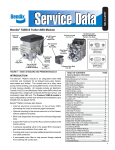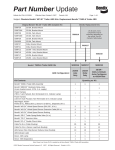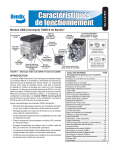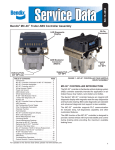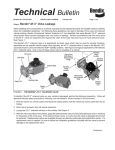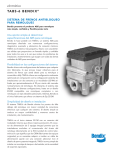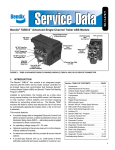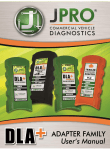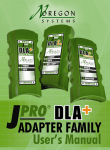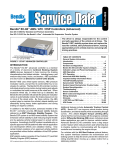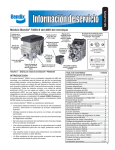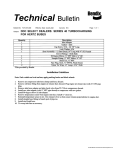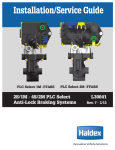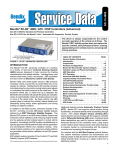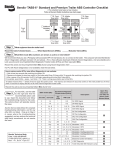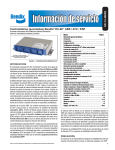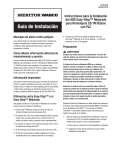Download BENDIX TABS-6 User's Manual
Transcript
SD-13-4767 Bendix® TABS-6 Trailer ABS Module ECU Cover (Sealed) 3/8" NPT Control Port with Integral Filter The ECU Connector Varies for Standard and Premium - See Chart ECU Connector Cover (Removable) Integrated Modulator Relay Valve 3/4" NPT Supply Port ECU Pin-out Label (See Page 31) Wheel Speed Sensor Connectors Through-holes for Frame (Chassis) Mounting Four (4) 3/8" NPT Delivery Ports (To Brake Chambers) Part Number Label (See Page 31) FIGURE 1 - TABS-6 standard and Premium MODULeS INTRODUCTION The Bendix® TABS-6 module is an integrated trailer ABS controller and modulator for air-braked heavy-duty trailers, semi-trailers and dollies. The module acts as a relay valve during normal braking, but during ABS events, it will intervene to help improve stability. All modules include an Electronic Control Unit (ECU) and Modulator Relay Valve (MRV) which are integrated into a single self-contained 2S/1M (two-sensor, one modulator) trailer ABS unit. The Premium TABS-6 module is auto-configurable to control more sensors and modulators (up to 4S/3M) from its default 2S/1M. Bendix® TABS-6 modules also feature: • Internal electrical connections to the primary MRV, eliminating the need for external pigtail harnesses. • Optional mounting to the service reservoir or to the chassis, without additional brackets. • Blink code diagnostics and support for advanced diagnostic tools. • Support for Power Line Carrier (PLC) communication to the towing vehicle. • A pressure equalizing valve in the sealed ECU housing to give improved protection from water, etc. • A locking dust cover to provide additional electrical connector and cable protection. • A serviceable nylon filter to help prevent foreign material from entering the control port. To Remove Cover Slide Lock Tab The Standard TABS‑6 Module uses a 5-Pin Connector The Premium TABS‑6 Module uses an 18-Pin Connector TABLE OF CONTENTS PAGE General System Information Introduction . . . . . . . . . . . . . . . . . . . . . . . . . . . . . . . 1 Safe Maintenance Practices . . . . . . . . . . . . . . . . . . 2 Components . . . . . . . . . . . . . . . . . . . . . . . . . . . . . . 2 Mounting Configurations . . . . . . . . . . . . . . . . . . . . . 2 PLC Communications . . . . . . . . . . . . . . . . . . . . . . . 2 Wiring Harness (Pigtail) . . . . . . . . . . . . . . . . . . . . . . 3 Power and Ground . . . . . . . . . . . . . . . . . . . . . . . . . .4 ABS Indicator Lamp . . . . . . . . . . . . . . . . . . . . . . . . . 4 Wheel Speed Sensors . . . . . . . . . . . . . . . . . . . . . . . 5 BR9235™ ABS Modulator Valve . . . . . . . . . . . . . . . . 5 J1708/J1587 Diagnostic Link . . . . . . . . . . . . . . . . . . 6 Auxiliary I/O . . . . . . . . . . . . . . . . . . . . . . . . . . . . . . . 6 ABS Flex™ Program . . . . . . . . . . . . . . . . . . . . . . . . . 6 Customer Scratch Pad . . . . . . . . . . . . . . . . . . . . . . .6 Power-up Sequence . . . . . . . . . . . . . . . . . . . . . . . . 6 ABS Operation . . . . . . . . . . . . . . . . . . . . . . . . . . . . . 7 Auto-Configuration . . . . . . . . . . . . . . . . . . . . . . . . . . 8 Odometer Function . . . . . . . . . . . . . . . . . . . . . . . . . 8 Non-standard Tire Size . . . . . . . . . . . . . . . . . . . . . . 8 Diagnostic Trouble Code Detection . . . . . . . . . . . . . 8 Blink Code Diagnostics . . . . . . . . . . . . . . . . . . . . . . 9 Bendix ABS Diagnostic Tools . . . . . . . . . . . . . . . . . 13 Contacting Bendix . . . . . . . . . . . . . . . . . . . . . . . . . 14 Servicing the Module . . . . . . . . . . . . . . . . . . . . . . . 14 Removing the Module . . . . . . . . . . . . . . . . . . . . . . 14 Service Replacement using the Module . . . . . . . . 15 Reinstallation . . . . . . . . . . . . . . . . . . . . . . . . . . . . . 15 Leakage And Operational Tests . . . . . . . . . . . . . . . 15 ABS Wiring . . . . . . . . . . . . . . . . . . . . . . . . . . . . . . 16 Troubleshooting . . . . . . . . . . . . . . . . . . . . . . . . . 17-27 SAFE MAINTENANCE PRACTICES WARNING! PLEASE READ AND FOLLOW THESE INSTRUCTIONS TO AVOID PERSONAL INJURY OR DEATH: When working on or around a vehicle, the following general precautions should be observed at all times: 1. Park the vehicle on a level surface, apply the parking brakes, and always block the wheels. Always wear safety glasses. 2. Stop the engine and remove ignition key when working under or around the vehicle. When working in the engine compartment, the engine should be shut off and the ignition key should be removed. Where circumstances require that the engine be in operation, EXTREME CAUTION should be used to prevent personal injury resulting from contact with moving, rotating, leaking, heated or electrically charged components. 3. Do not attempt to install, remove, disassemble or assemble a component until you have read and thoroughly understand the recommended procedures. Use only the proper tools and observe all precautions pertaining to use of those tools. 4. If the work is being performed on the vehicle’s air brake system, or any auxiliary pressurized air systems, make certain to drain the air pressure from all reservoirs before beginning ANY work on the vehicle. If the vehicle is equipped with an AD-IS® air dryer system or a dryer reservoir module, be sure to drain the purge reservoir. 5. Following the vehicle manufacturer’s recommended procedures, deactivate the electrical system in a manner that safely removes all electrical power from the vehicle. 6. Never exceed manufacturer ’s recommended pressures. 7. Never connect or disconnect a hose or line containing pressure; it may whip. Never remove a component or plug unless you are certain all system pressure has been depleted. 8. Use only genuine Bendix ® replacement parts, components and kits. Replacement hardware, tubing, hose, fittings, etc. must be of equivalent size, type and strength as original equipment and be designed specifically for such applications and systems. 9. Components with stripped threads or damaged parts should be replaced rather than repaired. Do not attempt repairs requiring machining or welding unless specifically stated and approved by the vehicle and component manufacturer. 10. Prior to returning the vehicle to service, make certain all components and systems are restored to their proper operating condition. 11. For vehicles with Antilock Traction Control (ATC), the ATC function must be disabled (ATC indicator lamp should be ON) prior to performing any vehicle maintenance where one or more wheels on a drive axle are lifted off the ground and moving. COMPONENTS Installations of the TABS-6 Module typically utilize the following components: • Bendix ® WS-24 ™ wheel speed sensors (2 or 4, depending on configuration). Each sensor is installed with a Bendix Sensor Clamping Sleeve. See page 5. • Bendix® BR9235™ Pressure Modulator Valves (0, 1, or 2 depending on configuration). See page 5. • Trailer-mounted ABS indicator lamp. See page 4. • Pigtail wiring harness(es) as needed. See page 3. MOUNTING configurations Tank (Nipple) Mount The TABS-6 modules can be tank-mounted using a schedule 80 (heavy gauge steel) 3/4" NPT nipple directly between the trailer supply tank and the module's supply port. A tank with a reinforced port must be used. Frame (Chassis) Mount The TABS-6 module provides through-holes for frame mounting directly to the trailer frame rail or cross-member. It is recommended to use two Grade 5 3/8-16 bolts, typical length 5", torqued to 180-220 in-lbs. Power Line carrier (plc) Communications Since March 1, 2001, all new towed vehicles transmit a signal over the power line to an in‑cab trailer ABS Indicator Lamp. The signal, using a heavy vehicle industry standard known as “PLC4Trucks,” is typically broadcast by the trailer ABS ECU over the blue wire (power line) of the J560 connector. See Figures 2 and 3. TABS-6 modules support PLC communications in accordance with SAE J2497. Identifying and Measuring the PLC Signal A TABS-6 module will continuously broadcast PLC messages that indicate trailer ABS status. At power-up or during a trailer ABS fault condition, the TABS-6 module will signal the tractor ABS unit to illuminate the dash-mounted trailer ABS indicator lamp. Diagnostic tools are available that detect the presence of a PLC signal and perform further system diagnostics directly on the power line. For more information on these diagnostic tools, contact Bendix or refer to your local authorized Bendix dealer or distributor. An oscilloscope can also be used to verify the presence and strength of a PLC signal on the power line. The PLC signal is an amplitude and frequency modulated signal. Depending on the load on the power line, the amplitude of the PLC signal can range from 5.0 mV p-p to 7.0 V p-p. PIGTAIL WIRING HARNESSes Several pigtail wire harnesses are available to connect the TABS-6 module with ABS and other trailer system components. Pigtail harness are weather sealed at the connector interface and are clearly labeled for proper installation. Because of the over-molded design of the TABS‑6 module wiring harnesses, Bendix recommends that the complete harness be replaced if damage or corrosion occurs. The following connector options may be present: FIGURE 2 - POWER LINE WITHOUT PLC SIGNAL Modulator 2 (MOD2), Modulator 3 (MOD3), auxiliary, diagnostic, and additional axle wheel speed sensors. Note: All TABS-6 modules include the two primary wheel speed sensor connections and therefore these are separate from the pigtail harness. ECU Connectors Standard TABS-6 module ECU connectors use a TTMA 97‑99 5‑pin Packard Weather Pack connector for brake light power, constant power, ground, the trailer-mounted ABS indicator lamp and a single auxiliary input/output (I/O). FIGURE 3 - POWER LINE WITH PLC SIGNAL Suggested oscilloscope settings are (AC coupling, 1 volt/ div, 100 µsec/div). The signal should be measured on pin 7 of the J560 connector at the nose of the trailer. 5-Pin Power and Indicator Lamp (POWER/ WL) Premium TABS-6 module ECU connectors use an 18-pin Deutsch DT series connector for the same function as above, plus additional modulators, wheel speed sensors and auxiliary I/O’s. 2-Pin Additional Wheel Speed Sensor Connectors (SAL & SAR) 18-Pin ECU Connector 3-Pin Modulator 2 (MOD2) Premium Pigtail Harness (4S/2M with diagnostic) 4-Pin Diagnostic Auxiliary (Optional) 3-Pin Modulator 3 (MOD3) (Optional) 5XXX.... B 5XXX... A E D To BR9235™ ABS Modulator Relay Valve To TABS-6 Module Pigtail Modulator Extension Harness To Diagnostic Tool 5-Pin Power and Indicator Lamp (POWER/WL) To TABS-6 Module Pigtail Optional Diagnostic C 5-Pin ECU Connector Standard Pigtail Harness (2S/1M) with optional diagnostic 5XXX... Diagnostic Tool Harness To ECU or Pigtail Wheel Speed Sensor Extension Harness To WS-24™ Wheel Speed Sensor FIGURE 4 - examples of Pigtail wire harnesses available Power/ABS Indicator Lamp Connector The TABS-6 module pigtail uses a TTMA RP 97-99 5-pin Packard Weather Pack connector for brake light power, constant power, ground and the trailer-mounted ABS indicator lamp. The Power/ABS indicator lamp lead of the pigtail harness is available in several lengths to satisfy most installation requirements (e.g. slider axles). Wheel Speed Sensor Connectors Two 2-pin connectors are provided for additional wheel speed sensors for 4S ABS applications. These 2-pin connectors are labeled Additional Sensor Left (SAL), and Additional Sensor Right (SAR). Extension cables are available in various lengths from Bendix. Circuit Ignition Power PLC (Blue Wire) Brake Light Power 7-Pin Trailer Conn. 5-Pin ABS Conn. 5-Pin18-Pin ECU ECU Conn. Conn. 7 B B 6 4 A A 12 1 E E 18 N/A D D 5 (Red Wire) Ground (White Wire) Indicator Lamp (White/green Wire) CHART 2 – Power and Ground ABS Modulator Connectors On Premium TABS-6 module pigtail harnesses, one or two modulator connectors are provided for trailers using two or three modulators. These 3-pin connectors are labeled MOD2 and MOD3. (Note: MOD1 designates the internal modulator of the TABS-6 module). Remote modulator harnesses are available in many lengths to satisfy most installation requirements. Diagnostic Connector Premium TABS-6 module pigtail harnesses provide a 4pin diagnostic connection for a diagnostic tool to monitor ECU ignition power, ground and data information. Remote diagnostic cables are available from Bendix to provide a standard J1708/J1587 diagnostic port at the side of the trailer. Auxiliary I/O Connector Standard TABS-6 module pigtails provide an option for a single auxiliary I/O. An optional auxiliary connector provides a connection to the TABS-6 module auxiliary I/O ECU pins. Premium ECU pigtails provides an option for up to six auxiliary I/O’s. ABS INDICATOR LAMP Trailer-mounted Lamp The TABS-6 module controls an ABS indicator lamp to show the trailer ABS status. With power supplied by the towing vehicle, the module illuminates the ABS indicator lamp by providing a 12.0 VDC signal. (The other side of the lamp is grounded.) The ABS indicator lamp output uses Pin D of the 5-pin Standard module connector, and Pin 5 of the 18-pin Premium module connector. Dash-mounted Lamp (PLC Controlled) POWER AND GROUND Trailer electrical power is supplied to the TABS-6 module from the ignition and brake light circuits. See Charts 1 and 2 for output values and pin locations. Function Mode Value Operating Range 8.0 to 16.0 VDC ECU Active 135 mA @ 12 VDC ABS Active (1 Modulator) 3.7 A @ 12 VDC ABS Active (2 Modulators) 5.2 A @ 12 VDC CHART 1 – Values for Outputs FIGURE 5 - trailer-mounted ABS indicator lamp TABS-6 modules use SAE J2497 standards to support Power Line Carrier (PLC) communication. The TABS-6 module transmits a signal over the power line to the towing vehicle. This information is used by towing vehicle’s ABS controller to know when to illuminate the trailer ABS indicator lamp mounted on the dash. The status of the trailer ABS is transmitted over the ignition power wire (blue wire of the J560 connector), Pin B of the 5‑pin Standard module connector, or Pin 6 of the 18-pin Premium module connector. Bendix® WS-24™ Wheel Speed Sensors Wheel speed data is provided to the TABS-6 module from the WS-24™ wheel speed sensors (see Figure 6). Vehicles have an exciter ring (or “tone ring”) as part of the wheel assembly, and as the wheel turns, the teeth of the exciter ring pass the wheel speed sensor, generating an AC signal. The TABS-6 module receives the AC signal, which varies in voltage and frequency as the wheel speed changes. (The default setting expects a 100-tooth tone ring to be used.) Vehicle axle and ABS control configurations determine if two or four wheel speed sensors are required. See page 17 for electrical system schematics showing wheel speed sensor connector pin locations. A proper sensor installation is critical to correct ABS operation. Typically, the WS-24™ sensor is installed in mounting blocks that are welded to the axle housing. WS-24™ wheel speed sensors are protected by a stainless steel sheath. They are designed to be used with beryllium copper clamping sleeves (sometimes referred to as a “retainer bushing”, “friction sleeve” or “clip”) (See Figure 6). The clamping sleeve provides a friction fit between the mounting block bore and the WS-24™ sensor. Sensor Clamping Sleeve 90° Speed Sensors Logo Stamped into Sleeve Straight Speed Sensors 5. Engage the connectors, and push together until the lock tab snaps into place. NOTE: It is important for the wheel bearings to be adjusted per the manufacturer's recommendations. The friction fit allows the WS-24™ sensor to slide back and forth under force but to retain its position when the force is removed. When the WS-24™ sensor is inserted all the way into the mounting block and the wheel is installed on the axle, the hub exciter contacts the sensor, which pushes the sensor back. Also, normal bearing play will “bump” the sensor away from the exciter. The combination of these two actions will establish a running clearance or air gap between the sensor and exciter. Excessive wheel end play can result in diagnostic trouble codes in cases where the sensor is pushed too far away from the tone ring. BENDIX® BR9235™ ABS Modulator Relay VALVES Bendix® BR9235™ modulator relay valves (MRV) are required when additional modulator relay valves are needed for multichannel brake systems (e.g. 2S/2M, 4S/3M ABS configurations). The MRV is an electro-pneumatic control valve and is the last valve that air passes through on the way to the brake chambers. The normally-open hold solenoid and normallyclosed exhaust solenoid are activated to precisely modify the brake pressure on command. During normal braking, the BR9235™ MRV functions as a standard relay valve. As brakes are applied or released by the driver, the control signal from the tractor foot valve causes the BR9235™ MRV to apply proportional pressure to the trailer brake chambers. The BR9235™ MRV is available in both tank and bracket mounting styles. FIGURE 6 - Bendix® WS-24™ WHEEL SPEED SENSORS 1. For increased corrosion protection we recommend that a high-temperature rated silicon- or lithium-based grease be applied to the interior of the mounting block, the sensor, and to a new clamping sleeve. 2. Install the new clamping sleeve fully into the block, with the retaining tabs toward the inside of the vehicle. Please note that WS-24™ wheel speed sensors must use the correct clamping sleeve to avoid problems associated with reduced retention force, such as sensor movement and resulting ABS trouble codes. 3. Gently push (DO NOT STRIKE) the sensor into the mounting block hole until it bottoms out on the face of the tone ring. Secure the cable lead wire to the knuckle/ axle housing 3-6 inches from the sensor. 4. Apply a moderate amount of dielectric non-conductive grease to both the sensor connector and harness connector. 3-Pin Modulator Solenoid Connector 3/8" NPT Supply Port with Integral Filter Four 3/8" NPT Delivery Ports (to Brake Chambers) FIGURE 7 - Bendix® BR9235™ Modulator relay valve Tank (Nipple) Mounted ABs Flex™ Program The BR9235™ MRV can be tank-mounted using a schedule 80 (heavy gauge steel) 3/4" NPT nipple directly between the trailer supply tank and the supply port. A tank with a reinforced port must be used. The ABS Flex™ program uses Auxiliary Design Language (ADL) to allow customized auxiliary functions to be carried out by the TABS-6 module. Programs developed in the ABS Flex™ program may be downloaded at the production line or in the field to control non-braking functions of the trailer. Bracket (Chassis) Mounted The BR9235™ MRV provides an option with a bracket for frame mounting directly to the trailer frame rail or crossmember. It is recommended to use two Grade 5, 3/8‑16 bolts, torqued to 180 – 220 in-lbs. J1708/J1587 DIAGNOSTIC LINK The Premium TABS-6 module provides a J1708/J1587 diagnostic link with data and power to communicate with the vehicle and various diagnostic tools. Diagnostics, testing, configuration, data transfer and other functions can be performed using this link. Diagnostic tools such as the MPSI Pro-Link™ device and Bendix® ACOM™ Diagnostic Software (version 4.0 and higher) support the TABS-6 Module. Ignition power must be provided to the TABS-6 module for the diagnostic link to be active. AUXILIARY I/O The Standard module provides for one auxiliary I/O function. The Premium module provides for up to five auxiliary functions and one additional ground. See Chart 3, below. Bendix® ACOM™ Diagnostic Software (version 4.0 and higher) supports the configuration of the TABS-6 module auxiliary I/O’s. Name ECU ECU Pin For example, ABS Flex ™ program can potentially communicate the status of: tire inflation and/or temperature; reefer temperature; load presence; slider pin position; lift axle position; proximity/reverse alarm; and vehicle weight. ABS Flex™ programs monitor the auxiliary I/Os and/or the SAE J1587 diagnostics and SAE J2497 PLC data links. Contact your Bendix Account Manager to discuss an ABS Flex™ program for your vehicle(s). CUSTOMER SCRATCH PAD The TABS-6 module has a Customer Scratch Pad feature which allows the customer, or end-user, to store up to 756 bytes of information. This information can then be read using the Bendix® ACOM™ Diagnostic Software (version 4.0 and higher). If additional scratch pad space is needed, this storage space can be expanded to 1K (1,008 bytes total of data). Contact Bendix for further details. POWER-UP SEQUENCE At power-up, the TABS-6 module performs a series of selfchecks that can assist a technician to determine the ABS system status and configuration. Auxiliary Functions • High-Side Driver… or Digital Input… AUX Standard C or • Analog Input None AUX1 Premium 16 • High-Side Driver… or Digital Input Modulator 3 (MOD3) Hold Solenoid AUX2 Premium 10 • High-Side Driver… or Digital Input Modulator 3 (MOD3) Release Solenoid AUX3 Premium 15 • High-Side Driver… or Digital Input Modulator 2 (MOD2) Hold Solenoid AUX4 Premium 9 • High-Side Driver… or Digital Input Modulator 2 (MOD2) Release Solenoid AUX5 Premium 4 • Low-Side Driver… or Analog Input Modulator 3 (MOD3) Common AUX6 Premium 3 • High-Side Driver… or Digital Input CHART 3 – Auxiliary I/Os and Default Functions Default Function J1587 Diagnostic Power ABS System Status Indicators Power Application 0.5 1.5 2.0 2.5 3.0 (sec.) Trailer-mounted ABS ON Indicator Light OFF Dash-mounted Trailer ON ABS Indicator Light (PLC OFF Detected)* Dash-mounted Trailer ON ABS Indicator Light (PLC Not Detected) OFF *Some vehicle manufacturers may illuminate the trailer ABS indicator lamp at power-up regardless of whether a PLC signal is detected from the trailer or not. Consult the vehicle manufacturer’s documentation for more details. FIGURE 8 - trailer ABS Lamp Start up sequence Trailer ABS indicator lamp At power-up without detected faults, the trailer ABS indicator lamp will turn on for 2.5 seconds as a bulb check and then turn off. See Figure 8. If a PLC-ready towing vehicle and trailer are powered at the same time, the TABS-6 module will also trigger a bulb check on the dash-mounted trailer ABS indicator lamp. Modulator Chuff Test at Power-Up At power-up, the TABS-6 module activates a modulator chuff test. This electrical and pneumatic ABS modulator test can help the technician identify problems with modulator installations and/or wiring. With brake pressure applied, a properly installed modulator will cause five rapid audible chuffs of air pressure. If additional modulators are installed, the TABS-6 module activates 5 chuffs at the internal modulator (MOD1) then for each additional modulator in sequence (e.g. MOD1, then MOD2, and then MOD3). The chuff sequence is then repeated. If the modulator is wired incorrectly, the modulator will only produce one chuff, or no chuff at all. If an issue is detected during the modulator chuff test, compare the modulator wiring and plumbing to the TABS-6 module’s electrical system schematic (see page 17) and make repairs. ABS OPERATION The TABS-6 module uses wheel speed sensors, modulator relay valves and an ECU to control trailer wheels by axle or by side. By monitoring individual wheel turning motion during braking, and adjusting or pulsing the brake pressure at each wheel, the TABS-6 module is able to optimize slip between the tires and the road surface. When excessive wheel slip, or wheel lock-up, is detected, the ECU will activate the Pressure Modulator Valves to modulate braking pressure at the wheel ends. The ECU is able to pump the brakes on individual wheels (or pairs of wheels), independently, and with greater speed and accuracy than a driver. Axle Control TABS-6 module axle control uses a single modulator relay valve to control wheels on both sides of a given axle or axles. In the case of an ABS event on road surfaces with poor traction (worn, slippery, or loose gravel roads) or areas of poor traction, (e.g. asphalt road surfaces with patches of ice), axle control will maintain the wheel that is not slipping at just under the speed that will lock the wheel. Temporary periods of wheel lock are permitted on the other wheel that is experiencing slippage. Axle control should not be used on 5th wheel dollies or steerable axles. When braking on even surfaces, an axle-control system will perform similar to a side control, two-modulator system. Axle control is available in 2S/1M, 2S/2M and 4S/2M installations, and for Modulator 3 (MOD3) in a 4S/3M installation. Dolly-Axle Control (Select Low) TABS-6 module dolly-axle control uses a single ABS modulator valve to control wheels from both sides of a given axle or axles. In the case of an unbalanced braking surface, (e.g. asphalt road surfaces with patches of ice), dolly axle control will control the low coefficient (slipping) wheel just under the lock limit. Vehicle stability is assisted by not allowing the high coefficient wheel (where traction is still being maintained) to sustain wheel lock. When braking on even surfaces, a dolly axle control system will perform similar to side control or axle control system. Dolly axle control is only available in 2S/1M installations. Side Control The TABS-6 module uses a single modulator relay valve to control one or more wheels on a given vehicle side. In the case of an unbalanced braking surface, the side control will individually control wheels on each side just under the point where they would lock up. Side control is available in 2S/2M and 4S/2M installations, and for the internal modulator (MOD1) and Modulator 2 (MOD2) in the 4S/3M installation. Normal Braking During normal braking, the TABS-6 module functions as a standard relay valve. If the ECU does not detect excessive wheel slip, it will not activate ABS control, and the vehicle stops with normal braking. AUTO-CONFIGURATION Service Interval The Standard TABS-6 module is available only in the 2S/1M ABS configuration and does not use auto-configuration. The TABS-6 module provides a feature that can be used to indicate a service interval for the trailer. The service interval can be accessed via PC or hand-held diagnostic tools. If configured, the TABS-6 module can flash the indicator lamp when the vehicle is at standstill to indicate when the service interval has been exceeded. For the Premium TABS-6 module, the default ABS configuration is 2S/1M. At power-up, if a Premium ECU detects additional sensors and modulators it will perform an auto-configuration. Auto-configuration only adjusts upward (e.g. 2S/2M Side to a 4S/2M Side configuration). Additional detected components that do not conform to a legitimate configuration will generate the appropriate faults. If the vehicle begins moving before the new configuration has been accepted, the reconfiguration will not take place at this time. Default Additional Components Auto-Configuration Sensors Modulators - - 2S/1M (Dolly-Axle) 2S/1M - 1 to 2S/2M (Side) Dolly Axle 2 1 to 4S/2M (Side) 2 2 to 4S/3M (Side/Axle) 2S/1M Axle - - 2S/1M (Axle) - 1 to 2S/2M (Axle) 2 1 to 4S/2M (Axle) CHART 4 – PREMIUM TABS-6 module AUTOCONFIGURATION MATRIX ODOMETER FUNCTION Odometer The TABS-6 module includes an odometer function to provide a means of storing the accumulated mileage of the vehicle. The mileage is computed by utilizing information calculated from the vehicle wheel speeds. This feature is accurate to within 0.62 miles per power-up and will typically store mileage up to 1,000,000 miles. The mileage can be displayed using PC diagnostics or through blink codes. Whenever the module is towed using a pre-1997 tractor, the electronic odometer does not function, and the mileage can be considered out-of-calibration. Trip Counter The module provides a counter to record the trip mileage. The feature is accessed through PC or handheld diagnostic tools. NON-STANDARD TIRE SIZE The module allows for tire rolling radius and tone ring tooth count parameters to be set for each axle using a diagnostic tool. These adjustments may be necessary for the module to accurately calculate the vehicle velocity and odometer mileage. Wheels of the same axle must be set to the same rolling radius and tone ring tooth count. In most cases, these parameters are set by the trailer OEM and do not need to be adjusted. In the case of a service replacement unit, always check that these parameters are set to match the vehicle. The tire-rolling radius is defaulted to 500 revs/mile and can be adjusted from 300 to 700 revolutions per mile. Refer to the manufacturer’s tire specification for correct values. Tone ring tooth count is defaulted to 100 teeth and can be set to 60 to 140 teeth. diagnostic trouble code DETECTION The TABS-6 module contains self-testing diagnostic circuitry that monitors the ABS components and wiring. When the module senses an erroneous system condition, it activates the external trailer-mounted ABS indicator lamp, disables all or part of the affected ABS functions, and it stores the fault code in memory, even when the power is removed. The module also uses PLC communications to send the system status to the towing vehicle. For some trouble codes, the TABS-6 module will automatically reset (“self-heal”) the active diagnostic trouble code when the error is corrected (e.g. when a wheel speed sensor is re-aligned). However, repeated occurrences of a given trouble code can cause the code to “latch” - that is, be retained as active, even if the condition is only intermittent. Once the code is latched, a manual reset will be necessary. Technicians can use these latched codes to assist them in troubleshooting intermittent errors. After the problem is repaired, trouble codes can be reset using blink code diagnostics or with a diagnostic tool. When a trouble code self-heals or is manually reset, the code remains stored in the ECU memory. This trouble code history can be retrieved using blink code diagnostics or with a diagnostic tool. Partial ABS Shutdown Depending on the trouble code detected, the ABS ECU partly or completely disables the ABS functionality. The trailer ABS system, for vehicles that only have one modulator, are disabled by any single fault. In the case of vehicles with two or three modulators, depending on the trouble code, the trailer ABS system may still provide some level of ABS function on axles/wheels that are not affected by the fault, but the ABS indicator lamp will remain on. In cases where the ABS is completely disabled, the vehicle reverts to normal braking (without ABS interventions). Always repair ABS shutdowns at the earliest opportunity. ECU Diagnostic Trouble Codes All ABS functions are completely disabled. The system reverts to normal braking. Voltage Diagnostic Trouble Code While voltage is out of range, the ABS functionality is disabled and the system reverts to normal braking. When the correct voltage level is restored, full ABS is typically available again. The operating voltage range is 8.0 to 16.0 VDC. BLINK CODE DIAGNOSTICS The TABS-6 module provides diagnostic and configuration functions through blink code diagnostics. This means that the technician, even without diagnostic tools, can read a series of ABS indicator lamp blinks to diagnose the trouble codes being generated. The blink code diagnostics mode is entered by providing constant power to the ignition circuit and toggling the brake light power input three times. With a parked towing vehicle attached, this is done by applying ignition power and after the power up sequence is complete, depressing and releasing the brake pedal three or more times, see below for chart. Depending on the blink code mode activated, the TABS‑6 module will blink the trailer-mounted ABS indicator lamp to display: active fault codes; fault code history; ABS configurations; and odometer mileage. Blink code diagnostics can also be used to reset active fault codes. With Ignition Power Applied, Cycle Brake Light Power Blink Code Action 3 times Display Active DTCs 4 times Display Inactive DTCs 5 times Clear Active DTCs 6 times Display Configuration 7 times Display Odometer Mileage 8 times Reset Configuration Wait until after the modulator chuff test before activating the brake light power. Following a single display of all available messages, the ABS indicator lamp will remain on for five seconds and then return to normal operating mode. Blink code diagnostics can only be activated following a power-up, where wheel speeds have not been detected. If the vehicle moves during blink code diagnostics mode, the module will cancel the blink code diagnostics and return to normal operating mode. Blink code diagnostics must be activated within the first 15 seconds of ignition power being applied. If brake light power is continuously applied for greater than five seconds, blink code diagnostics will be disabled until the next time the ignition power is cycled. Display Active Diagnostic Trouble Codes To display active codes, apply ignition power and depress / release the brake pedal 3 times within 15 seconds. Following activation, there will be a 5-second delay followed by a blink code display of all active fault codes. (See pages 10-12 for more information.) Display Diagnostic Trouble Code History To display trouble code history, apply ignition power and depress / release the brake pedal 4 times within 15 seconds. Following activation, there will be a 5-second delay followed by a blink code display of all history fault codes. (See pages 10-12 for more information.) Reset Active Diagnostic Trouble Codes To reset active codes, apply ignition power and depress / release the brake pedal 5 times within 15 seconds. Following activation, there will be a 5-second delay followed by a blink code message of: 1-1, (System Fully Operational - No Codes Detected) or a blink code display of all remaining active fault codes. The ABS indicator lamp will stay on if active DTCs are still present. Resetting active fault codes with blink code diagnostics does not clear information from trouble code history. Both blink code diagnostics or diagnostic tools can retrieve trouble code history, but only diagnostic tools can erase this information. CHART 5 – blink code information Display Configuration To check the ABS configuration, apply ignition power and depress / release the brake pedal 6 times within 15 seconds. Following activation, there will be a 5-second delay followed by a blink code display of the module's current ABS configuration. 1st Digit 2 4 2nd Digit 1 2 3 3rd Digit 1 2 3 4 5 6 Sensors 2 Sensors 4 Sensors Modulators 1 Modulator 2 Modulators 3 Modulators ABS Control Mode Axle Side Dolly-Axle MOD1 Axle - MOD2 Dolly-Axle MOD1 Axle - MOD2 Lift Axle Side (MOD1, MOD2) - MOD3 Dolly-Axle Display Odometer Mileage To display the trailer odometer mileage, apply ignition power and depress / release the brake pedal 7 times within 15 seconds. Following activation, there will be a 5-second delay followed by a blink code display of the odometer information (x1000). Example: 152,431 miles will be displayed as: 152 (x1000) or 1 blink (pause), 5 blinks (pause), 2 blinks. Zeros will be displayed by the ABS indicator lamp strobing twice. Odometer mileage cannot be altered with blink code diagnostics. Complete odometer information can be retrieved using a diagnostic tool. Resetting ABS Configuration To reset the ABS configuration to the default configuration, apply ignition power and depress / release the brake pedal 8 times within 15 seconds. Following activation, the TABS‑6 ABS configuration will reset to the default ABS configuration (2S/1M). CHART 6 – ABS configurations Diagnostic Trouble Codes (DTCs) 1st 2nd Fault Description Digit Digit 1 1 No faults Repair Information • ABS system fully operational – no faults detected J1587 J1587 (SID) (FMI) 1 0 Wheel Speed Sensors (WSS) 2 3 4 5 2 3 4 5 2 3 4 5 1 1 1 1 2 2 2 2 3 3 3 3 SL Sensor signal valid - large air gap SR Sensor signal valid - large air gap SAL Sensor signal valid - large air gap SAR Sensor signal valid - large air gap SL Sensor signal valid - loss of signal SR Sensor signal valid - loss of signal Dynamic Wheel Speed Sensor Fault. SAL Sensor signal valid - loss of signal Go to Section G, on Page 29. SAR Sensor signal valid - loss of signal SL Sensor signal valid – noisy SR Sensor signal valid – noisy SAL Sensor signal valid – noisy SAR Sensor signal valid – noisy 1 2 3 4 1 2 3 4 1 2 3 4 0 0 0 0 1 1 1 1 2 2 2 2 2 3 4 5 4 4 4 4 SL Sensor shorted or open SR Sensor shorted or open Static Wheel Speed Sensor Fault. SAL Sensor shorted or open Go to Section G, on Page 29. SAR Sensor shorted or open 1 2 3 4 4 or 5 4 or 5 4 or 5 4 or 5 2 3 4 5 5 5 5 5 SL Tire diameter out of range SR Tire diameter out of range SAL Tire diameter out of range SAR Tire diameter out of range • Verify correct tire size as desired. • Verify proper tire inflation. • Verify correct number of exciter ring teeth. • Verify that the ECU has the proper tire size settings. 1 2 3 4 13 13 13 13 • Verify correct ABS configuration using blink codes or other diagnostic tools. • If needed, reset to the default ABS configuration and power-up to initiate auto-configuration. 3 13 4 13 4 6 SAL Sensor configuration error 6 SAR Sensor configuration error 5 10 Diagnostic Trouble Codes (DTCs) (continued) 1st 2nd Fault Description Digit Digit Repair Information J1587 J1587 (SID) (FMI) Power 6 1 Over-voltage 6 2 Low-voltage 6 3 Excessive power line resistance • Power supply diagnostic trouble code. Go to Section F, page 28. • Power supply diagnostic trouble code. Go to Section F, page 28. • Power supply diagnostic trouble code. Go to Section F, page 28. 251 3 251 4 251 13 Modulator (MOD) 7 1 MOD1 Hold solenoid shorted or open 42 • Clear faults. 7 2 MOD1 Release solenoid shorted or • If faults return, replace the TABS-6 Module. 48 open 3, 4, 5 6 or 12 3, 4, 5 6 or 12 8 1 MOD2 Hold solenoid shorted or open 43 9 1 MOD3 Hold solenoid shorted or open 44 Static ABS Modulator Fault. 8 2 MOD2 Release solenoid shorted or Go to Section H, on Page 30. 49 open 9 2 MOD3 Release solenoid shorted or 50 open 3, 4, 5 6 or 12 3, 4, 5 6 or 12 3, 4, 5 6 or 12 3, 4, 5 6 or 12 7 8 9 3 3 3 MOD1 ABS modulator dynamic error Dynamic ABS Modulator Fault. MOD2 ABS modulator dynamic error Go to Section H, on Page 30. MOD3 ABS modulator dynamic error 7 8 9 7 7 7 8 13 9 13 8 4 MOD2 Valve configuration error 9 4 MOD3 Valve configuration error • Verify correct ABS configuration using blink codes or other diagnostic tools. • If needed, reset to the default ABS configuration and power-up to initiate auto-configuration. 10 1 Valve MOD1/2 low-side switch shorted to ground 10 2 Valve MOD3 low-side switch shorted to ground • Check for corroded/damaged wiring or connectors between the ECU and MOD. At the MOD harness connector, verify: • No continuity from modulator/AUX leads to ground. • After repairs or if no issues found, then clear faults. • If faults return, replace the TABS-6 Module. 7 4 9 4 10 3 Dynamic ABS Modulator Fault. Go to Section H, on Page 30. 7 7 Dynamic Wheel Speed Sensor Fault. Go to Section G, on Page 29. 1 7 254 12 254 13 Common ABS modulator dynamic error - all valves 10 4 Excessive ABS activity Electronic Control Unit (ECU) 11 1 ECU internal error 11 2 ECU configuration error • Check for damaged or corroded connectors. • Check for damaged wiring. • After repairs or if no issues found, then clear faults. • If faults return, replace the TABS-6 Module. • Verify correct ABS configuration using blink codes, PC-diagnostics or other off-board diagnostic tools. • If needed, reset to the default ABS configuration and power-up to initiate auto-configuration. (Continued over . . .) 11 Diagnostic Trouble Codes (DTCs) (continued) 1st 2nd Fault Description Digit Digit Repair Information J1587 J1587 (SID) (FMI) J1587 Diagnostic 12 1 J1587 diagnostics shorted or open • Check for corroded/damaged wiring or connectors 250 3, 4, 5 between the ECU and J1587 Diagnostic. or 12 • Verify the following: - At the 18-pin ECU harness connector: (a) Continuity of the J1587 Diagnostic wiring to the lamp (auxiliary device). (b) +12V is not measured at J1587 Diagnostic lead. - At J1587 Diagnostic connector: (a) No continuity of the J1587 Diagnostic lead to ground. (b) No continuity from J1587 Diagnostic lead to any other ECU pin(s). (c) Replace/repair J1587 Diagnostic wiring or components as required. Trailer-Mounted ABS Indicator Lamp 13 1 ABS lamp shorted or open 12 • Check for corroded/damaged wiring or connectors 81 between the ECU and ABS Indicator Lamp. • Verify the following: - At the 5-pin or 18-pin ECU harness connector: (a) Continuity of the ABS Indicator Lamp wiring to the lamp (auxiliary device). (b) +12V is not measured at ABS Indicator Lamp lead. - At ABS Indicator Lamp connector: (a) No continuity of the ABS Indicator Lamp lead to ground. (b) No continuity from ABS Indicator Lamp lead to any other ECU pin(s). (c) Replace/repair ABS Indicator Lamp wiring or components as required. 3, 4, 5 or 12 Troubleshooting: Using Hand-Held or PC-Based Diagnostic Tools Using hand-held or pc-based diagnostics LED lights illuminate Diagnostic Trouble Codes (10 LEDs) Troubleshooting and diagnostic trouble code clearing, as well as beginning a reconfiguration, may also be carried out using hand-held or PC-based diagnostic tools such as the Bendix® Trailer Remote Diagnostic Unit (TRDU™), Bendix® ACom™ Diagnostics software, or the ProLink tool. BENDIX ABS DIAGNOSTIC TOOLS Bendix® ACom™ Diagnostic Software Bendix ACom Diagnostic Software (version 4.0 or higher) is an RP-1210A compliant PC-based diagnostic software program that provides the highest level of diagnostic support for the TABS-6 module. With Bendix® ACom™ Diagnostic Software, maintenance personnel can: ® ™ • Obtain fault information (both active and inactive faults) • Retrieve event history • Clear inactive faults and event history • Verify ECU configuration • Perform system and component tests • Read/write customer information on scratch pads • Save and print information • Receive troubleshooting assistance When diagnosing the TABS-6 module using a PC and Bendix® ACom™ Diagnostic Software, the computer’s serial or parallel port can be connected to the vehicle’s diagnostic connector through a RP-1210A compliant communications device. For more information on the Bendix® ACom™ Diagnostic Software, or RP-1210A compliant tools, contact Bendix or refer to your local authorized Bendix parts outlet. Figure 15 - The Bendix® Trailer Remote Diagnostic Unit Bendix® TRDU™ (Trailer Remote Diagnostic Unit) Tool The Bendix® TRDU™ tool provides the technician with a visual indication of Antilock Braking System (ABS) component Diagnostic Trouble Code (DTC) information. The TRDU™ tool is specifically designed for use with Bendix® Trailer ABS systems and Bendix makes no claims for its operation and/or usability with other brands of trailer ABS. Features of the Bendix® TRDU™ Tool The TRDU™ tool attaches to a 7-pin to 7-pin adapter (See Figure 17) and then into the J560 of the towing vehicle. The TRDU™ tool communicates across PLC. The TRDU™ tool allows the technician to: • Troubleshoot ABS system component problems using Diagnostic Trouble Code reporting via LEDs. • Reset Diagnostic Trouble Codes on Bendix® ABS ECUs by holding a magnet over the reset of the TRDU™ tool for less than 6 seconds. • Initiate a self-configuration event Mode used by Bendix® ABS ECUs by holding a magnet over the reset area for greater than 6 seconds but less than 11 seconds. LED Diagnostic Trouble Codes Lap Top Computer Parallel or Serial Cable J1708/J1587 or J1939 PDM (RP-1210A) FIGURE 14 - Bendix ABS Diagnostic Software VLT - ECU - SEN - MOD1 - MOD2 - Power ABS Controller Wheel Speed Sensor Modulator 1 Modulator 2 MOD3 - LFT - RHT - ADD - ODO - Modulator 3 Left Right Additional Odometer Example: If the Diagnostic Trouble Code is "Right Additional Sensor", the TRDU ™ tool will display one green and three red LEDs LEDs Green VLT Blue ODO All others are Red FIGURE 16 - DIAGNOSTIC trouble COdes 13 Bendix® TRDU™ Tool Reset Function The magnetic reset switch is located by the letter "B" in the Bendix logo on the top of the TRDU™ tool. Activation requires a magnet with 30 gauss minimum. TRDU™ Tool to Trailer Connector to Towing Vehicle J560 Connector Adapter FIGURE 17 - TRDU™ tool and adapter How the Bendix® TRDU™ Tool Operates When the TRDU™ tool is plugged into the adapter, and the adapter/TRDU™ tool is installed between the trailer connector and the J560 connector of the towing vehicle, all the LEDs will illuminate, and the green LED will flash 4 times to indicate communications have been established. If the ABS ECU has no active Diagnostic Trouble Codes, only the green LED will remain illuminated. If the ABS ECU has at least one active Diagnostic Trouble Code the TRDU™ tool displays the first diagnostic trouble code by illuminating the red LEDs, indicating the malfunctioning ABS component and its location on the vehicle. (See Figure 18.) If there are multiple diagnostic trouble codes on the ABS system, the TRDU™ tool will display one diagnostic trouble code first, then once that Diagnostic Trouble Code has been repaired and cleared, the next code will be displayed. The TRDU™ tool repeatedly blinks out the mileage stored once communications have been established. By counting the sequence of blinks and/or strobes on the blue LED the odometer reading is given. See page 10 for more details. • VLT (Flashing indicates either over- or under-voltage condition) To pinpoint the root cause and to ensure the system diagnostic trouble code is properly corrected the first time, additional troubleshooting may be necessary. The reset operations are: 1. If the magnet is held over the switch for less than 6 seconds the "clear diagnostic trouble codes" command is sent. 2. If the magnet is held over the switch for more than 6 seconds, but less than 11 seconds, the Bendix® ABS "self-configuration command" is sent. Additionally, it is recommended at the end of any inspection that the user switches off and restores the power to the ABS ECU, then check the ABS Indicator Lamp operation and TRDU™ tool to see if they indicate any remaining Diagnostic Trouble Codes. MPSI Bendix Cartridge MPSI provides a Bendix cartridge for use with the ProLink™ tool. For more information on the Bendix diagnostic cartridge from MPSI, contact Bendix or refer to your local authorized Bendix parts outlet. PLC Diagnostic Tool Diagnostic tools are available that detect the presence of a PLC signal and perform further system diagnostics directly on the power line. For more information on these diagnostic tools, contact Bendix or refer to your local authorized Bendix parts outlet. Pro-Link Heavy Duty Multi Protocol Cartridge PC Card MPSI Part Number 805013 FIGURE 19 - nExIQ (MPSI) pro-link tool CONTACTING BENDIX www.Bendix.com The Bendix on-line troubleshooting guide will help you determine the cause performance issues with your braking system. FIGURE 18 - TRDU™tool LED Locations 14 The Bendix on-line contacts directory will make it easy for you to find the Bendix contacts you need. From this page, you can navigate to technical support contacts, service engineers, Bendix account managers, international contacts and more. Bendix.com is your complete Bendix resource. REMOVING THE TABS-6 module Bendix Technical Assistance Team 2. Disconnect the 5 or 18-pin ECU connector and the two 2-pin wheel speed sensor connectors. For direct personal technical support, call the Bendix technical assistance team at: 1-800-AIR-BRAKE (1-800-247-2725), Monday through Friday, 8:00 A.M. to 6:00 P.M. EST, and follow the instructions in the recorded message. Alternatively, you may e-mail the Bendix technical assistance team at: [email protected]. To better serve you, please record the following information before you call the Bendix Tech Team, or include this information in your e-mail: • Bendix product model number, part number and configuration. • Vehicle make and model. • Vehicle configuration. (Number of axles, tire size, etc.) • System performance symptoms: When do they occur? • What faults have been identified using LEDs, blink codes or diagnostic tools? • What troubleshooting/measurements have been performed? • What Bendix service data literature do you have or need? Servicing the TABS-6 Module CAUTION: All TABS-6 modules are initially defaulted to 2S/1M and may auto-configure to another ABS configuration if additional sensors and/or ABS modulators are detected. An incorrect ABS configuration may cause fault indication or degraded ABS performance. Before and after activating a self-configuration, always check the current ABS configuration by using blink code diagnostics or a diagnostic tool. Prior to performing service to the TABS-6 module, always perform the following steps: 1. Follow all Safe Maintenance Practices including, but not limited to, those on page 2 of this document. 2. Turn power off. 3. Drain the air pressure from all reservoirs. 4. Remove as much contamination as possible prior to disconnecting electrical connections and air hoses. 5. Note the TABS-6 module's mounting position on the vehicle. 1. Open the cover by sliding the locking tab to the left. Retain the cover. 3. Mark for reinstallation and then remove all air hoses and plugs connected to the module. 4. Remove the module from the vehicle by removing the mounting fasteners or by rotating the entire assembly counter-clockwise from the tank mount. SERVICE REPLACEMENT OF OTHER ABS CONTROLLERS The TABS-6 module is designed to be used as the service replacement part for the Bendix ® MC-12 ™ , MC‑30 ™ and A‑18 ™ trailer ABS controllers. When controller service replacement parts are required, a TABS-6 module and pigtail harness must replace the entire MC‑12™, MC‑30™ or A‑18™ controller assembly and pigtail harness. When replacing an MCE‑12™ controller, the integral emergency function (EV‑2™ valve) must be replaced by a DC-4™ and TR-3™ valve combination. See pages 1821 for plumbing details. TABS-6 module kits are available to replace all MC-12 ™, MC‑30™ and A‑18™ controller assemblies and harnesses. For more information, contact Bendix or your local authorized Bendix parts outlet. 1. Disconnect the power connector and wheel speed sensors from the MC-12™ or MC-30™ controller pigtail harness. 2. Remove all air hoses and plugs connected to the unit. 3. Remove the MC-12™ or MC-30™ controller assembly and pigtail from the vehicle by removing the mounting bracket nuts or by rotating the entire assembly counter clockwise from the tank nipple mount. 4. Install the new pigtail, starting at the power connector and properly securing the harness every 18 inches to the ECU location. 5. Next, refer to the Reinstallation of the TABS-6 Module section. REINSTALLATION OF THE TABS-6 module CAUTION! All TABS-6 module service replacement parts are initially defaulted to 2S/1M and may autoconfigure to another ABS configuration if additional sensors and/or ABS modulators are detected. An incorrect ABS configuration may cause fault indication or degraded ABS performance. Before and after activating a self-configuration, always determine the current ABS configuration by activating blink code diagnostics. Inspect the original mounting hardware: If it is in good condition, it can be reused for installation. If replacement 15 hardware is needed, use grade-5 3/8-18 bolts, nuts and lock washers for the frame-mount unit, or a schedule 80 (heavy gauge steel) ¾" nipple for the tank-mount unit. Inspect the location selected for installation and clean as necessary. NOTE: Inspect all components, including the replacement trailer ABS module, for any external damage, such as cracked valve ports, electronic housings, etc. Any components found to be damaged should not be installed on the vehicle and must be replaced. 1. Position and secure the unit in the original mounting orientation (the exhaust port must point straight down): For tank-mount modules: Install the nipple fitting into the modulator-valve supply port. Then rotate the entire assembly into the tank port until secure. Over-torquing of the tank nipple could cause damage to the valve body. For frame-mount modules: Torque the mounting nuts to 180-220 in-lbs. 2. Reconnect all air hoses and plugs to the module. Depending on the installation, additional plugs may be necessary. Make certain that no thread sealing material enters the valve. All air hoses and fittings should be checked for leaks prior to returning the vehicle to service. 3. Reconnect the ECU and wheel speed sensor electrical connectors to the unit. Apply a moderate amount of non-conductive electrical grease to each connector pin before reconnecting. 4. The new TABS-6 module may need to be reconfigured for proper operation. See page 8. 5. Leakage and Operational Tests must be performed before returning the vehicle to service. LEAKAGE AND OPERATIONAL TESTS 1. Before performing leak tests, block the wheels. 2. Fully charge air brake system and verify proper brake adjustment. 3. Make several trailer brake applications and check for prompt application and release at each wheel. 4. Check the module, modulator valve(s) and all air hose fittings for leakage using a soap solution: 16 Check the ABS solenoid body with the trailer service brakes fully applied. If leakage is excessive, more than a single 1" bubble within 1 minute, replace the module. Check the relay exhaust port with the trailer service brakes released to be sure that leakage is less than a single 1" bubble within 3 seconds. If excessive leakage is detected at the relay exhaust port, perform the following test before replacing the module: • Apply the trailer spring brakes. Recheck for leakage around the relay exhaust port. If the exhaust port stops leaking, this indicates a leak between the emergency and service sides of the spring brake chamber. However, if the relay exhaust port continues to leak excessively, replace the TABS-6 module. 5. Apply power and monitor the power-up sequence to verify proper system operation. See page 6. 6. Determine the current ABS configuration by activating blink code diagnostics or using a diagnostic tool. If necessary, reset the ABS configuration and allow the module to auto-configure. See page 8. 7. Calibrate and set odometer parameters if necessary using a diagnostic tool. Refer to the Odometer Function section on page 8. 8. Where a safe location (e.g. restricted access area or test track) is available, it is possible to road test the ABS function by making an abrupt stop from a vehicle speed of about 20 MPH to check for proper function. The wheels should not enter a prolonged lock condition and ABS function should be audible. It is the responsibility of the technician to perform this test in a safe location. ABS WIRING All connector leads of the TABS-6 module pigtail harness are weather sealed at the connector interface and are clearly labeled for proper installation. Bendix provides over-molded versions of the TABS-6 wiring harness and Bendix recommends that the complete harness be replaced if corrosion or damage occurs. When troubleshooting ABS wiring, some general rules should be followed where applicable. 1. Check all wiring and connectors to ensure they are secure and free from visible damage (e.g. cuts, abrasions, etc.). 2. Check for evidence of wire chafing due to poor routing, or poor securing, of wires. 3. Check connectors for proper insertion and locking. 4. Verify that the connector pins are properly greased with a non-conductive electrical grease compound. 5. Connector terminals must not show signs of corrosion or exposure to the environment. 6. Never pierce wire insulation when checking for continuity. 7. Do not deform individual pins or sockets during probing with a volt/ohm meter. 8. It is strongly recommended to properly secure all wiring harness and sensor leads at least every 18 inches. 9. Apply a moderate amount of non-conductive electrical grease to each connector pin before reconnecting. Troubleshooting: Electrical Schematics Figure 20 - Standard tabs-6 module (5-pin ecu connector) electrical schematic - 2S/1M 7-WAY SAE J560 CONNECTOR 1 SENSOR RIGHT SR 7 SENSOR RIGHT SR (+) 1 SENSOR RIGHT SR (-) 2 GROUND 4 IGNITION VOLTAGE BRAKE LAMP VOLTAGE ABS WARNING LAMP (AUX7) TRAILER-MOUNTED ABS WARNING LAMP SENSOR ADD. RIGHT SAR SENSOR ADD. RIGHT SAR (+) 1 SENSOR ADD. RIGHT SAR (-) 2 MODULATOR VALVE MOD2 SENSOR ADD. LEFT SAL 1 2 MOD1/2 COMMON 2 MOD2 HOLD 3 MODULATOR VALVE MOD3 6-WAY SAE J1587 CONNECTOR MOD2 RELEASE 1 1 2 3 C 18 6 12 5 11 17 9 3 15 10 MOD3 COMMON 4 MOD3 HOLD SENSOR ADD. LEFT SAL (+) SENSOR ADD. LEFT SAL (-) J1587 (A) A 2 MOD3 RELEASE J1587 (B) B 1 16 8 PREMIUM TABS-6 Trailer ABS Controller 14 7 1 J1587 GROUND 13 E J1587 VOLTAGE (AUX6) SENSOR LEFT SL 1 2 SENSOR LEFT SL (+) SENSOR LEFT SL (-) 2 1 2 Figure 21 - Premium tabs-6 module (18-pin ecu connector) electrical schematic - 4s/3M 17 Troubleshooting: System Schematics 2S/1M - AXLE CONTROL Light Power B Ignition Power C NC Bendix® WS-24™ Wheel Speed Sensor "SR" Right “Curb-Side” A Brake D A C B E D Warning Lamp Trailer Chassis Harness 7-PIN CONNECTOR Ground E Ground 5-PIN CONNECTOR Trailer ABS Pigtail Harness Bendix® SR-5™ Trailer Spring Brake Valve SUPPLY LINE Ignition Power TABS CONTROL LINE Bendix® TABS-6 Trailer ABS Module Brake Light Power Dual Axle Trailer ABS 18 ABS Indicator Lamp Left “Road-Side” Bendix® WS-24™ Wheel Speed Sensor "SL" Troubleshooting: System Schematics (continued) WS Sensor "SR" 2S/2M - AXLE CONTROL A B C D E Brake Light Power Ignition Power NC Warning Lamp Ground Right - “Curb-Side” D A C B E CONTROL LINE Ground 5-PIN CONNECTOR Trailer ABS Pigtail Harness “MOD2” Bendix® BR9235™ Modulator Relay Valve SR-5™ Trailer Spring Brake Valve SUPPLY LINE Ignition Power TABS Trailer Chassis Harness 7-PIN CONNECTOR “MOD1” TABS-6 Trailer ABS Module Brake Light Power Dual Axle Trailer ABS Light ABS Left - “Road-Side” WS Sensor "SL" Installation Guidelines for the TABS-6 2S/2M Axle ABS Configuration: o o o o MOD1 (TABS-6 ABS Unit) controls the left “road-side” wheel(s) of a primary axle(s). MOD2 (Bendix® BR9235™ Modulator Unit) controls the wheels of an additional axle(s). SL & SR (Primary Sensors) senses wheels on the primary axle (always on ground) that MOD1 controls. For lift axle applications, MOD2 controls the wheels for the lift-able axle WS Sensor "SR" 2S/2M - SIDE CONTROL A B C D E Brake Light Power Ignition Power NC Warning Lamp Ground Right - “Curb-Side” D A C B E CONTROL LINE Ground 5-PIN CONNECTOR Trailer ABS Pigtail Harness SR-5™ Trailer Spring Brake Valve SUPPLY LINE Ignition Power TABS Trailer Chassis Harness 7-PIN CONNECTOR Bendix® BR9235™ Modulator Relay Valve “MOD2” “MOD1” TABS-6 Trailer ABS Module Brake Light Power Dual Axle Trailer ABS ABS Light Left - “Road-Side” WS Sensor "SL" Installation Guidelines for the TABS-6 2S/2M Side ABS Configuration: o MOD1 (TABS-6 ABS Unit) controls the left “road-side” wheel(s) of a primary axle(s). o MOD2 (Bendix® BR9235™ Modulator Unit) controls the right “curb-side” wheel(s) of a primary axle(s). o For lift axle applications, SL & SR (Primary Sensors) senses the wheels of the stationary, non lift-able axle 19 Troubleshooting: System Schematics (continued) WS Sensor "SAR" 4S/2M - AXLE CONTROL A B C D E Brake Light Power Ignition Power NC Warning Lamp Ground D A C B E Right “Curb-Side” WS Sensor "SR" CONTROL LINE Trailer Chassis Harness Ground 5-PIN CONNECTOR “MOD2” Bendix® BR9235™ Modulator Relay Valve SR-5™ Trailer Spring Brake Valve SUPPLY LINE Ignition Power Trailer ABS Pigtail Harness TABS 7-PIN CONNECTOR “MOD1” TABS-6 Trailer ABS Module Brake Light Power ABS Light Full Trailer ABS Left “Road-Side” WS Sensor "SAL" WS Sensor "SL" Installation Guidelines for the TABS-6 4S/2M Axle ABS Configuration: o MOD1 (TABS-6 ABS Unit) controls the left “road-side” wheel(s) of a primary axle(s). o MOD2 (Bendix® BR9235™ Modulator Unit) controls the wheels of an additional axle(s). o SL & SR (Primary Sensors) senses wheels on the primary axle (always on the ground) that MOD1 controls, and are connected to the dedicated 2-pin connector on the TABS-6 ECU. o SAL & SAR (Additional Sensors) senses the wheels that MOD2 controls, and are connected to the 18-pin connector on the TABS-6 ECU. o For lift axle applications, MOD2 controls the wheels for the lift-able axle WS Sensor "SAR" 4S/2M - SIDE CONTROL A B C D E Brake Light Power Ignition Power NC Warning Lamp Ground WS Sensor "SR" Right - “Curb-Side” D A C B E CONTROL LINE Trailer Chassis Harness 7-PIN CONNECTOR Trailer ABS Pigtail Harness “MOD2” SR-5™ Trailer Spring Brake Valve SUPPLY LINE Ignition Power TABS Ground 5-PIN CONNECTOR Bendix® BR9235™ Modulator Relay Valve “MOD1” TABS-6 Trailer ABS Module Brake Light Power Dual Axle Trailer ABS ABS Light Left - “Road-Side” WS Sensor "SAL" WS Sensor "SL" Installation Guidelines for the TABS-6 4S/2M Side ABS Configuration: o MOD1 (TABS-6 ABS Unit) controls the left “road-side” wheel(s) of a primary axle(s). o MOD2 (Bendix® BR9235™ Modulator Unit) controls the right “curb-side” wheel(s) of a primary axle(s). o SL & SR (Primary Sensors) are connected to the dedicated 2-pin connector on the TABS-6 ECU. o SAL & SAR (Additional Sensors) are connected to the 18-pin connector on the TABS-6 ECU. o For lift axle applications, SAL & SAR (Additional Sensors) senses the wheels of the lift-able axle 20 Troubleshooting: System Schematics (continued) 4S/3M - SIDE/AXLE CONTROL Brake Light Power Ignition Power NC Warning Lamp Ground D A C B Right “Curb-Side” E CONTROL LINE Trailer Chassis Harness 7-PIN CONNECTOR Ground WS Sensor "SR" 5-PIN CONNECTOR Trailer ABS Pigtail Harness Bendix® BR9235™ Modulator Relay Valve “MOD3” SUPPLY LINE SR-5™ Trailer Spring Brake Valve Ignition Power Bendix® BR9235™ Modulator Relay Valve “MOD2” TABS A B C D E WS Sensor "SAR" “MOD1" TABS-6 Trailer ABS Module Brake Light Power Tri-Axle Trailer ABS ABS Light Left “Road-Side” WS Sensor "SAL" WS Sensor "SL" Installation Guidelines for the TABS-6 4S/3M Side/Axle ABS Configuration: o MOD1 (TABS-6 ABS Unit) controls the left “road-side” wheel(s) of a primary axle(s). o MOD2 (Bendix® BR9235™ Modulator Unit) controls the right “curb-side” wheel(s) of a primary axle(s). o MOD3 (Bendix® BR9235™ Modulator Unit) controls the wheels of an additional axle(s). o SL & SR (Primary Sensors) senses wheels on the primary axle (always on the ground) that MOD1 controls, and are connected to the dedicated 2-pin connector on the TABS-6 ECU. o SAL & SAR (Additional Sensors) senses the wheels that MOD3 controls, and are connected to the 18-pin connector on the TABS-6 ECU. o For lift axle applications, MOD3 controls the wheels for the lift-able axle 21 Troubleshooting Flowcharts Diagnostic trouble code information can be retrieved from the TABS-6 module by using blink code diagnostics, or a diagnostic tool. The following troubleshooting flow charts will help the technician isolate the cause of the fault and confirm whether the fault resides in the component, wiring or connectors. Troubleshooting should always begin by observing the dash or trailer-mounted ABS indicator lamp during the TABS-6 module's power-up sequence. If it is necessary to make electrical measurements, always begin by taking voltage and resistance measurements at the 5 or 18-pin ECU pigtail harness connector. Once the circuit fault is found, isolate the area needing repair by repeating the measurements at all connections in the affected circuit towards the modulator, wheel speed sensor, etc. No voltage or resistance measurements are to be made on the bulkhead connector pins of the module. Troubleshooting Flowcharts Section A : (Power-Up Sequence) Trailer-Mounted ABS Indicator Lamp . . . . . . . Page 23 Section B: (Power-Up Sequence) Dash-Mounted ABS Indicator Lamp . . . . . . . . Page 24 Section C: Diagnostic Trouble Code (DTC) Blink Code Quick Reference . . . . . . . . . . . . . . . . . . . Page 25 Section D: Diagnostic Trouble Code TRDU™ Tool LED Quick Reference . . . . . . . . . . Page 26 Section E: Troubleshooting the Trailer-Mounted ABS Indicator Lamp Circuitry . . . . . . . . . . . . . Page 27 Section F: Troubleshooting the Power Supply . . . . . . . . . Page 28 Section G: Troubleshooting the WS-24™ Wheel Speed Sensors . . . . . . . . . . . . . . . . . . . . . . . . . . Page 29 Section H: Troubleshooting the BR9235™ Modulator Relay Valves . . . . . . . . . . . . . . . . . . . . . . . . . . . Page 30 22 Section A: (Power-Up Sequence) Trailer-Mounted ABS Indicator Lamp 23 Section B: (Power-Up Sequence) Dash-Mounted ABS Indicator Lamp 24 Section C: Diagnostic trouble code (DTC) blink code Quick reference 1st Blink Code Code Location 2nd Blink Code Code Description 1 All 1 No Diagnostic Trouble Codes 2 Sensor SL 1 Sensor signal valid - large air gap 3 Sensor SR 2 Sensor signal valid - loss of signal 4 Sensor SAL 3 Sensor signal valid - noisy 5 Sensor SAR 4 Sensor shorted or open 5 Tire diameter out of range 6 Sensor configuration error 6 Power 1 Over-voltage 2 Low-voltage 3 Excessive power line resistance 7 Valve MOD1 1 Hold solenoid (AUX) shorted or open 2 Release solenoid (AUX) shorted or open 8 Valve MOD2 3 ABS modulator dynamic error 9 Valve MOD3 4 Valve configuration error 10 Common 1 Valve MOD1/2 low-side switch shorted to ground 2 Valve MOD3 (AUX) low-side switch shorted to ground 3 ABS modulator dynamic error - all valves 4 Excessive ABS activity 11 ECU 1 ECU internal error 2 ECU configuration error 12 Diagnostics 1 J1587 diagnostics (AUX6) shorted or open 13 Indicator Lamp 1 ABS lamp (AUX7) shorted or open Repair Information • System fully operational - no faults detected • Go to Section G - Dynamic WSS DTCs • Go to Section G - Dynamic WSS DTCs • Go to Section G - Dynamic WSS DTCs • Go to Section G - Static WSS DTCs • Verify correct tire size, proper tire inflation & correct number of exciter ring teeth. Verify that the ECU has the proper tire size settings. • Verify correct ABS configuration. If needed, reset to the default ABS configuration and power-up to initiate auto-configuration. • Go to Section F - Power Supply • Go to Section F - Power Supply • Go to Section F - Power Supply • Go to Section H - ABS Modulator DTCs • Go to Section H - ABS Modulator DTCs • Go to Section H - ABS Modulator DTCs • Verify correct ABS configuration. If needed, reset to the default ABS configuration and power-up to initiate auto-configuration. • Go to Section H - ABS Modulator DTCs • Go to Section H - ABS Modulator DTCs • Go to Section H - ABS Modulator DTCs • Go to Section G - Dynamic WSS DTCs • Check for damaged or corroded connectors. Check for damaged wiring. After repairs or if no issues found, then clear faults. If faults return, replace the module. • Verify correct ABS configuration. If needed, reset to the default ABS configuration and power-up to initiate auto-configuration. • Check for corroded/damaged wiring or connectors between the ECU and J1587 Diagnostic (AUX6). Replace/repair J1587 Diagnostic (AUX6) wiring or components as required. • Go to Section E - Trailer ABS Indicator Lamp To Read/Clear Diagnostic Troubleshooting Codes (DTCs): 1. Apply constant power to the trailer (ignition switch). 2. Within 15 seconds, apply/release the brake pedal at 1 second intervals: (a) 3 times for displaying Active DTCs. (b) 4 times for displaying Inactive DTCs. (c) 5 times for clearing Active DTCs. 3. After 5 seconds delay, the blink codes will be displayed. 4. Observe the trailer-mounted ABS indicator lamp and record blink code(s). 5. Refer to blink code chart for description. 6. After making repairs and clearing Active DTCs, verify lamp is no longer illuminated. 25 SECTION D: DIAGNOSTIC TROUBLE CODE (DTC) TRDU™ tool LED QUICK REFERENCE Power System OK - A solid green VLT LED indicates proper voltage is reaching the module. If no red LEDs are on, then no DTC's are detected. If the ABS indicator lamp is on with no red LEDs, Go To Section E, page 27. Voltage Out of Range - A flashing green VLT LED indicates ECU voltage below 8.0 VDC or above 16.0 VDC. The VLT LED will flash until power is brought into normal range. Go to Section F, page 28. No Voltage - When the VLT LED is off, the module is receiving very low or no voltage, or there is no communication to TRDU. The ECU LED may be on in this case. Go to Section F, page 28. ABS Modulator DTC The red M1, M2 and/or M3 LED is on to indicate a DTC with an ABS modulator. The example above shows the LEDs illuminated when there is a DTC for a second ABS modulator (MOD2). The indicated modulator DTC may be static or dynamic. Static DTCs are related to wiring or component failures such as open or short circuits. Dynamic modulator DTCs are related to abnormal wheel speed behaviors during ABS. Go to Section H, page 30. O M1 OD 26 Magnetic Reset - All LEDs will be on while a magnet is held in place at the RESET location near the “B” in Bendix. When held for less than 6 seconds, the DTCs are cleared. When held for more than 6 seconds,the ABS configuration is reset. If one or more LEDs do not illuminate, replace the TRDU™ tool. Do not reset the DTC codes until troubleshooting of the indicated component is complete. Wheel Speed Sensor DTC The red SEN LED is on to indicate a DTC with a wheel speed sensor. The example above shows the LEDs illuminated when there is an additional right sensor (SAR) DTC. Troubleshooting and repair are the same for a DTC on any wheel speed sensor. The indicated sensor DTC may be static or dynamic. Static DTCs are related to wiring or component failures such as open or short circuits. Dynamic DTCs are related to abnormal wheel speed signals or behaviors. Go To Section G, page 29. ECU DTC The red ECU LED is on to indicate a DTC internal to the TABS-6 module. Reset the TRDU™ tool with a magnet. If the DTC returns, replace the module. If the red ECU LED is on and the green VLT LED is off, the module may have very low voltage. In this case, go to Section F. Odometer Mileage - The TRDU will continously display the odometer information (x1000) by flashing the blue ODO LED. There will be a 20 second pause between ODO displays. As an example: 152,431 miles will be displayed as: 152 (x1000) ... or 1 blink (pause), 5 blinks (pause), 2 blinks. Zeros are displayed by the blue ODO LED strobing twice. SECTION E: TROUBLESHOOTING THE TRAILER-MOUNTED ABS INDICATOR LAMP CIRCUITRY Looking into Standard TABS6 Module Wire Harness (Pin D ABS Indicator Lamp) Looking into Premium TABS-6 Module Wire Harness (Pin 5 ABS Indicator Lamp) 27 SECTION F: TROUBLESHOOTING THE POWER SUPPLY Measure the loaded voltage across a type 1157 brake light bulb. Looking into Premium TABS-6 Module Wire Harness, ECU Connector Measure: Pin 6 (Ignition Power) to Pin 18 (ground) and Pin 12 (Brake Light Power) to Pin 18 (ground) 28 Looking into Standard TABS-6 Module Wire Harness, ECU Connector Measure: Pin B (Ignition Power) to Pin E (ground) and Pin A (Brake Light Power) to Pin E (ground) SECTION G: TROUBLESHOOTING THE WS-24™ WHEEL SPEED SENSORS (WSS) Looking into Wire Harness(es) SR Sensor 1 - Right (Curb) Sensor + 2 - Left (Curb) Sensor - SL Sensor 1 - Left (Road) Sensor + 2 - Right (Road) Sensor - Looking into Premium TABS-6 Module Wire Harness when Additional Wheel Speed Sensors are used: SAR: 11 - Additional Right (Curb) Sensor + 17 - Additional Right (Curb) Sensor - SAL: 8 - Additional Left (Road) Sensor + 14 - Additional Left (Road) Sensor 29 SECTION H: TROUBLESHOOTING THE MODULATOR RELAY VALVES Premium TABS‑6 Module Wire Harness for BR9235™ Modulator Valve Connector Looking into Modulator Connector Pins: Pin 1 (Release) Pin 2 (Common) Pin 3 (Hold) 30 (Optional) Looking into ECU Connector: Pin 9 is MOD2 release Pin 3 is MOD2 Common Pin 15 is MOD2 Hold Pin 10 is MOD3 release Pin 4 is MOD3 Common Pin 16 is MOD3 Hold Bendix Part Number Date of Manufacture Code 5-Pin ECU Pin-Out 2-Pin Sensor Pin-Out and Routing Info Number Showing the Initial Software Loaded (Software may be revised on the production line or in the field.) Bendix Part Number Bendix Part Number 2-Pin Sensor Pin-Out and Routing Info 18-Pin ECU Pin-Out Figure 22 - Label information ECU Part Number Label The external part number label is located on the relay valve portion of the module. Label shown above is located under the removable cover of the TABS-6 module. If the part number label is not readable or is painted over, the ECU part number and revision can be read using a diagnostic tool. The number of the initial software loaded on the ECU is also indicated. The module part number, and pin-out information is shown on the label beneath the removable cover. Software Revision Level The current software revision number can be read using a diagnostic tool. Document Revision Level Please visit Bendix.com to ensure you have the latest version of this document. 31 BW2469 ©2007 Bendix Commercial Vehicle Systems LLC • All Rights Reserved • 3/07 • Printed in U.S.A. 32
































